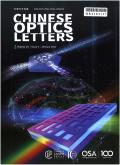基于3D打印的太赫兹多层衍射透镜逆设计
IF 2.8
2区 物理与天体物理
Q2 OPTICS
引用次数: 0
摘要
太赫兹(THz)透镜在成像和通信系统中有许多应用。目前,常见的太赫兹透镜仍然基于传统的圆凸透镜设计。在这项工作中,我们提出了一种设计3D打印多层太赫兹透镜的方法,利用3D打印技术提供的优势,包括紧凑的尺寸,轻量化的结构和成本效益。该方法采用逆向设计方法,采用优化方法来保证准确的性能。为了减少模拟时间,我们采用圆柱坐标系下的时域有限差分法进行近场计算,并将其与Rayleigh-Sommerfeld衍射理论相结合进行远场计算。该技术在太赫兹成像、传感和通信领域具有巨大的应用潜力,为设计和开发在太赫兹频率范围内工作的功能器件提供了一种新的方法。本文章由计算机程序翻译,如有差异,请以英文原文为准。
Inverse design on terahertz multilevel diffractive lens based on 3D printing
Terahertz (THz) lenses have numerous applications in imaging and communication systems. Currently, the common THz lenses are still based on the traditional design of a circular convex lens. In this work, we present a method for the design of a 3D-printed multilevel THz lens, taking advantage of the benefits offered by 3D printing technology, including compact size, lightweight construction, and cost-effectiveness. The approach utilizes an inverse design methodology, employing optimization methods to promise accurate performance. To reduce simulation time, we employ the finite-difference time-domain method in cylindrical coordinates for near-field computation and couple it with the Rayleigh–Sommerfeld diffraction theory to address far-field calculations. This technology holds great potential for various applications in the field of THz imaging, sensing, and communications, offering a novel approach to the design and development of functional devices operating in the THz frequency range.
求助全文
通过发布文献求助,成功后即可免费获取论文全文。
去求助
来源期刊

Chinese Optics Letters
物理-光学
CiteScore
5.60
自引率
20.00%
发文量
180
审稿时长
2.3 months
期刊介绍:
Chinese Optics Letters (COL) is an international journal aimed at the rapid dissemination of latest, important discoveries and inventions in all branches of optical science and technology. It is considered to be one of the most important journals in optics in China. It is collected by The Optical Society (OSA) Publishing Digital Library and also indexed by Science Citation Index (SCI), Engineering Index (EI), etc.
COL is distinguished by its short review period (~30 days) and publication period (~100 days).
With its debut in January 2003, COL is published monthly by Chinese Laser Press, and distributed by OSA outside of Chinese Mainland.
 求助内容:
求助内容: 应助结果提醒方式:
应助结果提醒方式:


